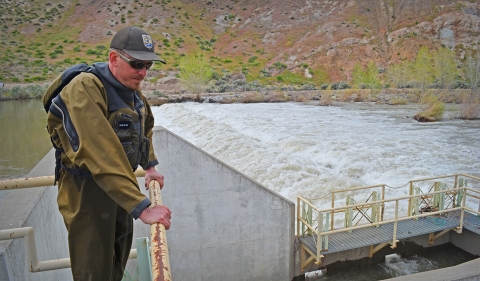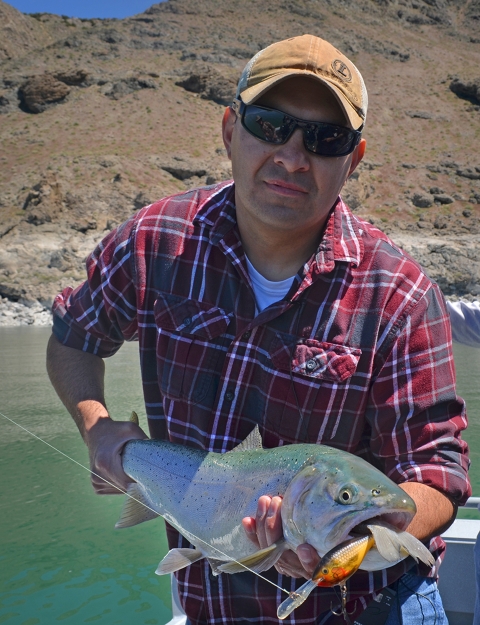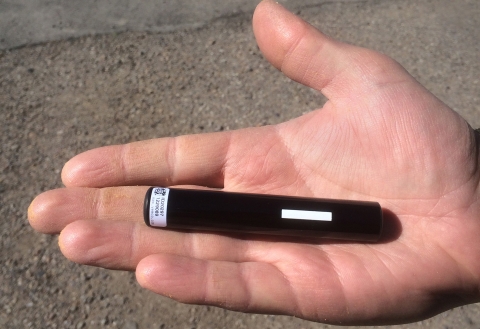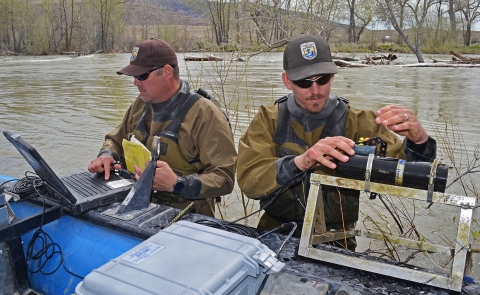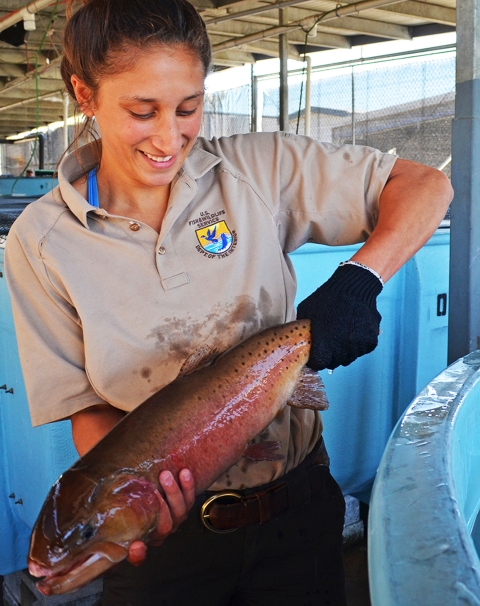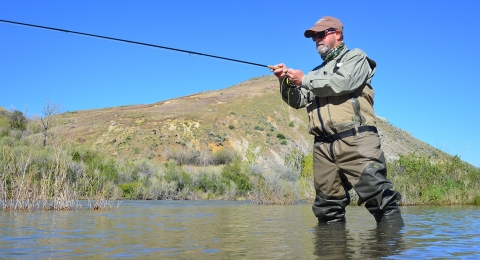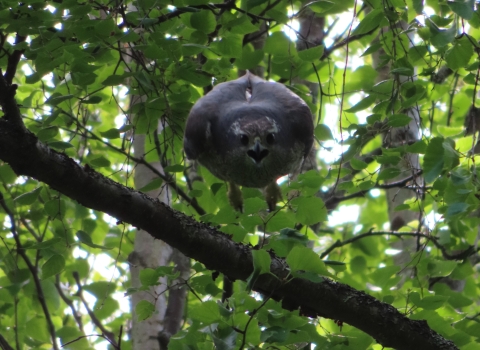Thanks to more than 700 inches of Sierra Nevada snow this winter and record-high water flows, the prehistoric “monster” Pilot Peak strain of Lahontan cutthroat trout is migrating farther into native Nevada waters than it has in more than 80 years.
Drought-breaking precipitation combined with two decades of conservation actions by the U.S. Fish and Wildlife Service’s Lahontan National Fish Hatchery Complex and Pyramid Lake Paiute Tribe have helped the fish, once thought to be extinct, to successfully migrate from Pyramid Lake into the lower Truckee River for spawning.
“Last year was the first time we observed the cutthroat moving out of the lake and spawning naturally in the lower reaches of river since the hatchery first began raising them from our brood stock in 1995 and stocking them in the lake with the help of the tribe in 2006,” said Lisa Heki, project leader for the hatchery complex. “This year they’re using the high water flows to run even further up into territory they haven’t been documented in since the late 1930s.”
Historical records describe an era when native trout migrated more than 120 miles from Pyramid Lake to Lake Tahoe unhindered by man-made barriers or introduced predators. Angling stories by Gold Rush settlers in the late 1800s told of 60-pound “monster salmon trout” that were abundant in the river.
By 1940, the fish had vanished from the system. Now, federal, state and tribal partners are building on the recovery and unique genetic preservation work by the hatchery to boost the Truckee’s world-class sport fishery with the return of the state fish of Nevada.
“To see these fish we’ve raised from eggs in the hatchery growing to massive sizes in the lake over the past few years and now watching them run up the river has been the most rewarding experience in fish conservation I’ve ever had,” said Roger Peka, a Lahontan National Fish Hatchery fish biologist. “To get them all the way up into the full span of their range one day will be an amazing accomplishment for our hatchery, and something we can all be proud of."
The Nevada Department of Wildlife recently closed angling within 1,000 feet of Derby Dam, located about 30 miles upstream from the lake, just outside the Pyramid Lake Paiute tribal boundary. Derby dam is the furthest point hatchery biologists are allowing the fish to migrate this year as they work quickly in the raging, 5,000-plus cubic-feet-per-second water flows to gather new information on the trout’s behavior in the river.
The dam is the first of a series of four man-made Truckee River barriers the fish will encounter when they pass upstream from the reservation that will be remediated by the Service and its partners with improved, natural fish passageways over the next few years.
“Now that we’ve seen these big trout of up to 20 pounds or more being able to migrate out of the lake, their presence will become an important part of re-establishing them in the river, and will one day give anglers the opportunity to catch a native fish that’s found nowhere else in the world right in their own backyard,” said Jon Sjoberg, chief of fisheries for NDOW. “Our agreements with the Service and the tribe to protect this species will help ensure this trout has a home as it moves further up into the Truckee.”
“After all the incredible work the U.S. Fish and Wildlife Service and the tribe have done bringing this trout back from the brink of extinction, it’s a great next step that the state is taking to put regulations into place to further protect these fish,” said angling guide Doug Ouellette, who has fly-fished the Truckee’s waters for the past 45 years. “You can fish for brown and rainbow trout anywhere in the country, but these are a dream-of-a-lifetime trophy native fish that belong here and deserve the chance to return to their home. You’re going to start seeing anglers coming from all over the world for the opportunity to land one.”
Collecting new data amidst a record water year has proven both challenging and highly beneficial to the partnering biologists, who are eager to see how the fish are adapting to their first-ever river experience. Their goal is to document when and where the fish are spawning, how they’re using the habitat and how fast they’re moving upstream.
To help track migration, the Service’s hatchery biologists have enlisted sophisticated tracking technology provided through a two-year National Fish and Wildlife Foundation grant that involves surgically implanting select fish with a transponder when they leave Pyramid Lake. The implant sends out an acoustic signal from the fish in a 600-yard radius that biologists can track with a hand-held receiver as they float stretches of river aboard a raft. Traditional Passive Integrated Transponder receiver stations along the river also record the passage of fish tagged with the technology.
This year’s run of the Pilot Peak cutthroat is also being measured in conjunction with the similar-timed spawn of rainbow trout, which provides an opportunity for biologists to see if hybridization with the river’s introduced species will be a factor in the future.
Noting how the fish are using the new environment is crucial, as development of natural variable instream flow and habitat improvement programs along the Truckee have been a vital part of the Service’s conservation strategy since restoration of the species was first envisioned in 1992.
The reproductively mature adults in a population that breed (or spawn) and produce more individuals (offspring or progeny).
Learn more about broodstock tanks. Credit: Dan Hottle/USFWS
The high water is not only facilitating the advancement of spawning cutthroat, but its extreme hydrologic forces are also creating ever-changing new eddy pools and side channels that will be optimal places for juvenile cutthroat to hide, feed and grow and get acquainted with their new river life.
The rise and fall of the water levels from the nearby mountain range’s runoff is also helping cottonwood trees that provide shade and nutrients for the fish along the banks establish deeper, healthier root systems.
The Service and its partners will continue to evaluate the success of the Lahontan cutthroat in the Truckee River over the next several years, eventually allowing them to migrate above Derby Dam once fish screen, river temperature and flow conditions allow, and as fish passage fish passage
Fish passage is the ability of fish or other aquatic species to move freely throughout their life to find food, reproduce, and complete their natural migration cycles. Millions of barriers to fish passage across the country are fragmenting habitat and leading to species declines. The U.S. Fish and Wildlife Service's National Fish Passage Program is working to reconnect watersheds to benefit both wildlife and people.
Learn more about fish passage improvement work continues to clear their historic path.
“I hope to one day see a family looking down over the Virginia Street Bridge in downtown Reno or as far up as Lake Tahoe watching these fish spawn in the place where they truly belong,” Peka said.


